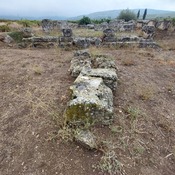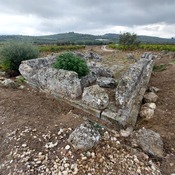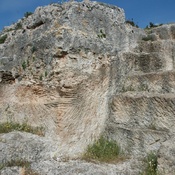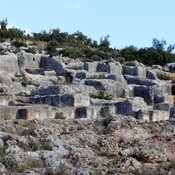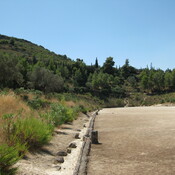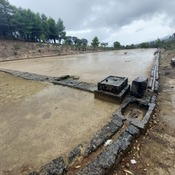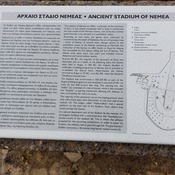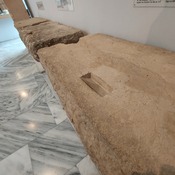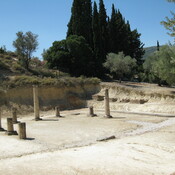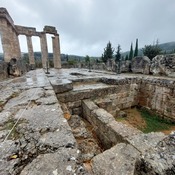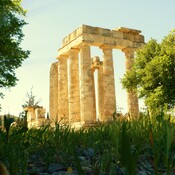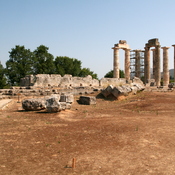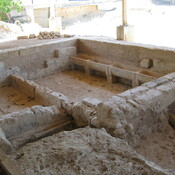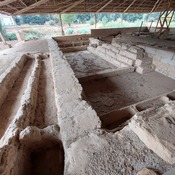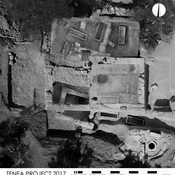Er zijn nog geen Nederlandstalige annotaties. Hier volgen annotaties in het Engels.
Cleonae or Kleonai was a small city in ancient Peloponnesus, described by writers of the Roman period as a city of Argolis. Pausanias: On the road from Corinth to Argos is a small city Cleonae. They say that Cleones was a son of Pelops, though there are some who say that Cleone was one of the daughters of Asopus, that flows by the side of Sicyon. Be this as it may, one or other of these two accounts for the name of the city. Here there is a sanctuary of Athena, and the image is a work of Scyllis and Dipoenus.1 Some hold them to have been the pupils of Daedalus, but others will have it that Daedalus took a wife from Gortyn, and that Dipoenus and Scyllis were his sons by this woman. Cleonae possesses this sanctuary and the tomb of Eurytus and Cteatus. The story is that as they were going as ambassadors from Elis to the Isthmian contest they were here shot by Heracles, who charged them with being his adversaries in the war against Augeas1.
The site was inhabited from Helladic Period since Homer in the second book of the Iliad presents it as part of Agamemnon's dominionsin his Cathalog of Ships 2
Kleonai was built on two hills, with the Acropolis on the eastern hill measuring around 80 × 180 m. An extensive terrace southeast of the Acropolis is called the Lower Acropolis. A first city wall initially only enclosed the Acropolis including this terrace. Later the western city hill and the southern lower town were also included. On the western hill, early and late Mycenaean pottery sherds (1500–1190 BC) were found. The Athena temple on the Acropolis mentioned by Pausanias has not as yet been located. It had housed a statue of Athena by the sculptors Dipoinus and Scyllis.
See:
- Pausanias, Description of Greece II. 15
- William Smith, ed. , sv. "Cleonae". Dictionary of Greek and Roman Geography. 1. London: John Murray 1854, p. 634.
- Marchand, Jeannette C. “Kleonai, the Corinth-Argos Road, and the ‘Axis of History.’” Hesperia: The Journal of the American School of Classical Studies at Athens, vol. 78, no. 1, 2009, pp. 107–63. JSTOR, http://www.jstor.org/stable/40205745. Accessed 9 Dec. 2023.
Bronverwijzingen
- ↑Paus. II.15
- ↑And they that held Mycenae, the well-built citadel, and wealthy Corinth, and well-built Cleonae...
Cleonae or Kleonai was a small city in ancient Peloponnesus, described by writers of the Roman period as a city of Argolis. Pausanias: On the road from Corinth to Argos is a small city Cleonae. They say that Cleones was a son of Pelops, though there are some who say that Cleone was one of the daughters of Asopus, that flows by the side of Sicyon. Be this as it may, one or other of these two accounts for the name of the city. Here there is a sanctuary of Athena, and the image is a work of Scyllis and Dipoenus.1 Some hold them to have been the pupils of Daedalus, but others will have it that Daedalus took a wife from Gortyn, and that Dipoenus and Scyllis were his sons by this woman. Cleonae possesses this sanctuary and the tomb of Eurytus and Cteatus. The story is that as they were going as ambassadors from Elis to the Isthmian contest they were here shot by Heracles, who charged them with being his adversaries in the war against Augeas1.
The site was inhabited from Helladic Period since Homer in the second book of the Iliad presents it as part of Agamemnon's dominionsin his Cathalog of Ships 2
Kleonai was built on two hills, with the Acropolis on the eastern hill measuring around 80 × 180 m. An extensive terrace southeast of the Acropolis is called the Lower Acropolis. A first city wall initially only enclosed the Acropolis including this terrace. Later the western city hill and the southern lower town were also included. On the western hill, early and late Mycenaean pottery sherds (1500–1190 BC) were found. The Athena temple on the Acropolis mentioned by Pausanias has not as yet been located. It had housed a statue of Athena by the sculptors Dipoinus and Scyllis.
See:
- Pausanias, Description of Greece II. 15
- William Smith, ed. , sv. "Cleonae". Dictionary of Greek and Roman Geography. 1. London: John Murray 1854, p. 634.
- Marchand, Jeannette C. “Kleonai, the Corinth-Argos Road, and the ‘Axis of History.’” Hesperia: The Journal of the American School of Classical Studies at Athens, vol. 78, no. 1, 2009, pp. 107–63. JSTOR, http://www.jstor.org/stable/40205745. Accessed 9 Dec. 2023.
Bronverwijzingen
- ↑Paus. II.15
- ↑And they that held Mycenae, the well-built citadel, and wealthy Corinth, and well-built Cleonae...

